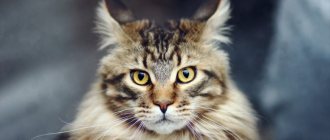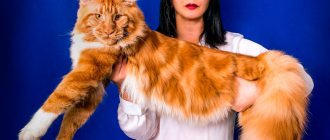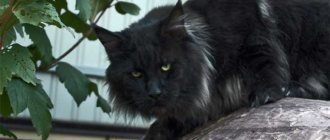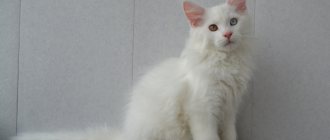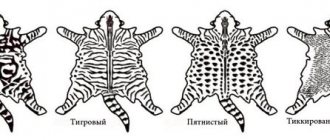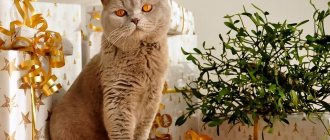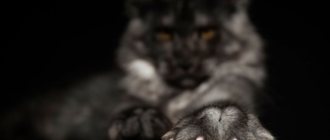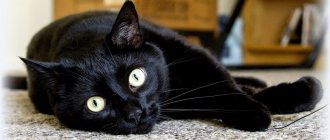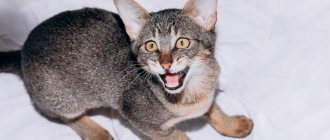The ideal cat for home keeping is considered to be the Black Smoke Maine Coon, whose appearance is mesmerizing. The most valuable coat color among representatives of the breed is deep black. Animals are endowed with a good-natured character, a gentle and kind disposition. The Maine Coon cat is large in size, naturally well-mannered, graceful, and behaves proudly and independently.
Description and appearance
Approved breed standards
| Body parts | Features of cats black smoke |
| Torso | Strong, proportional with well-developed muscles |
| Limbs | Powerful, front legs slightly shorter than the hind legs, oval in shape |
| Head | Medium in size, elongated towards the nose and tapering towards the forehead |
| Eyes | Round in shape, large, black cats are often green or gray in color |
| Ears | Wide set, large with tassels at the tips |
| Tail | Elongated and fluffy, tapering towards the end |
| Wool | Soft, silky, pleasant to the touch, undercoat present |
| Depending on the variety, the color varies from white-black to silver-black | |
| Color | Maine Coons black smoke can be solid, marbled or smoky colors |
| Smoky are divided into types: chinchilla and shaded smoke |
The presence of several extra toes on a Maine Coon cat's paws is not considered a “defect.”
The body weight of cats reaches 15 kilograms, and that of females up to 10-13. These animals are not artificially bred, the breed is of natural origin. Maine, where cats originate, has a cold climate. For this reason, nature has endowed them with a dense, thick coat with a warm undercoat that protects them from freezing. The main feature of the breed is considered to be the polydactyl nature of the cats. Cats can have up to 2-3 extra toes on their paws, however, this is not a breed defect.
EMS classification
To simplify the names for entering information into documentation, they created the EMS system (stands for Easy Mind System). A special complex for encoding shades and patterns, and other parameters, allows you to reflect all the nuances in letter and number combinations.
Each coat color received its own Latin letter designation:
- n – black, one of the primary colors.
- a – blue, this color appears after the black color is lightened.
- d – red – the second primary color of animals.
- e – cream, appears when red is lightened.
- f - tortoiseshell - characteristic of cats, but practically never found in cats, tortoiseshell color looks like a unique combination of black and red, which is never duplicated, like human fingerprints.
- g – creamy blue tortoiseshell appears as a result of lightening the usual color in a tortoiseshell combination.
- w – white, although it is essentially not a color, but its absence. If a cat has at least one spot of a different color, it is no longer white.
According to the breed standard, certain shades of coat are not allowed: sorrel and lilac, fawn and chocolate, gold and cinnamon. The same applies to unrecognized tortoiseshell colors: lilac and fawn, blue and cinnamon, and some others.
White color
There are digital codes for the white color in an animal's coloration. The lower the indicator, the higher the percentage of white wool:
- 01 – van (van) – the coat is almost completely white, but there are two colored spots on the head, the tail is a different color. There is also a small spot at the shoulders.
- 02 – harlequin – differs from the previous type by the presence of several multi-colored spots of different sizes on the back.
- 03 – bicolor – white wool accounts for half of the total mass.
- 09 – the presence of white (unspecified amound of white) – the color is present on the paws, on the chest.
The color with a white spot on the chest is called a medallion, with one or more clear spots - buttons. The white bottom of the paws is known as gloves, and their combination with the medallion and dark color of the back is known as a tuxedo. All other codes for spotting with white belong to other cat breeds.
Eyes and their color
Maine Coon eye colors are usually not taken into account in the EMS code, but some eye color combinations have their own names and coding:
- Tin is a silver marbled black cat with orange eyes.
- Silver is the same color, but combined with green eyes.
- The odd-eyed Maine Coon receives the code w 63.
A white Maine Coon with blue eyes is usually deaf because the amount of pigment in the body is related to the development of the hearing system.
Color varieties: tabby
Based on their color, all Maine Coons are divided into several categories:
- Striped type (“Tabby”).
- Monochromatic color (“Solid”).
- Smoky shades (“Smoke”).
- Turtle coloring pages.
- Marble.
- White spots.
- Random color combination.
Tabby is considered the original color of wild cats. Tabby Maine Coons have thin lines on their faces that form the letter M on their forehead. Each hair is colored with both light and dark stripes, this type of alternation is called “agouti”.
Tabby coloring can be:
- Brindle or Mackerel - stripes running vertically and parallel.
- Classic (Classic or blotched) - large width stripes on the sides in the form of a spiral, similar to marble patterns.
- Spotted or Spotted - there are intermittent stripes across the entire surface of the body, forming spots.
- Ticked (Ticked or Abyssinian) - there are no stripes or spots on the body, but there is a pattern on the muzzle, and agouti runs along the body. This color is not recognized as part of the Maine Coon breed.
The color of a tabby is determined by the color of the tip of the tail or stripes. A certain digital classification is provided for the drawing. 22 is marbled, 23 is dashed or “mackerel”, 24 is spotted, 25 is ticked. Sometimes the number 21 indicates a fuzzy pattern.
The basic rule here is simple: the larger the picture, the smaller the number by which it is designated. The most popular animals are the colors black and red tabby marble.
Solid color
The solid solid color appeared in the process of suppressing the recessive tabby genes. Sometimes a fuzzy shadow pattern remains, which is called shadow. Solid color is a uniform, rich coat color throughout the body with hair coloring from the base to the very tip. Residual patterns and light undercoat are considered a fault, and marks of a different color are considered defective.
The color of solids can be black or red, white or blue, sometimes cream. The black Maine Coon looks very beautiful, but requires more frequent brushing than cats of other colors. This is necessary to renew the coat and remove dead brown hairs, especially during shedding. Proper nutrition also plays an important role.
The black and white Maine Coon (black with a white spot) belongs to the bicolor class.
In the red color it is difficult to achieve the absence of a pattern, since the tabby gene is very strong. Cats of this color are often called red Maine Coons; they almost always have a slight pattern.
The blue solid color is rare. The color of the fur of these animals is gray with an ashy and even slightly bluish color. Cream Maine Coons are produced by lightening the red color and have a ginger-tinged coat.
Tortoiseshell colors
The tortoiseshell color with black is called torbi (torbi) in combination with brownish and red, torti (torti) - with a cream component. The classic tortoiseshell color is called blue-cream. With this coloring, white markings sometimes appear. Other names are blue tortie or dilute tortie. The name of the color with inserts of cream and blue shades is blue patched tabby.
A color with white spots that have clear boundaries is called calico. Coloring with cream color and splashes of blue - dilute calico. For an arbitrary volume of white there is a name patched tabby and white. The black marbled cat is also called a forest cat, because in color it resembles its wild ancestor.
The spots can be an independent part of the color or complement the stripes. Such elements appear in the form of lightened back of the ears, darkened surroundings of the nose and eyes, shaded stripes on the cheeks, a necklace on the neck, bracelets on the limbs, and buttons on the abdomen.
Silver and smoky shades
Cats of silver or smoky colors look very impressive. Silver is a practical white coat with an undercoat closer to the skin by a third of the length. Immediately after birth, kittens appear white, but have green eyes. Cream animals are also born white, with a haze of cream color appearing gradually. This shade has its own letter designation –s (means silver). When the colored wool is plain, without a pattern, the same letter in the code means “smoky” (translated as smoke).
The result is the following encodings:
- ns – black smoke;
- as – blue smoke;
- ds – red smoke;
- es – creamy smoke;
- fs – turtle smoke;
- gs – blue cream tortoiseshell smoke.
For genetic reasons, the ws combination does not exist.
Based on the length of the dyed hairs, they can be classified as smoky (colored on half the length), shaded (colored on 1/4), and chinchilla (saturated color on an eighth of the hair).
A random combination of shades means a color that includes several shades, but without white inclusions. These are brown spotted tabby, creamy blue and blue spotted. Any solid color is considered a rare color. Getting this option is difficult, and keeping it is even more difficult. A rare occurrence is the birth of a solid-colored animal from parents who have any pattern on their fur.
In the photo: Maine Coon color ds – red smoke
Character and behavior
Representatives of the Black Smoke Maine Coon breed are endowed with a kind, playful, affectionate character. They become strongly attached to their owner and require attention and care on his part. The main feature of pets is the ability to “talk”. Cats make sounds that are not like meowing, but can be compared to human conversation. Animals come to the place where the owner is resting and lie down next to him. They get along well with children, but are in no hurry to play with them.
Cats are independent, proud individuals. They will never touch the bowl of other animals in the house, will not take the owner's food from the table and will not beg. They love to have fun with toys, they quickly flirt, and the ball is especially interesting for them. Maine Coons Black Smoke do not tolerate parting well with their owner, even if he leaves for a short time, they are seen off at the door and always greeted.
If there is a need to go on a business trip, it is recommended to think through options with whom to leave a representative of the breed, otherwise he may get bored.
Varieties
The color of animals can be of various shades, which are inherited, for example, black solidus is considered rare.
The coat color of Maine Coons has a rich palette of shades: blue, cream (beige), tortoiseshell, red (red), snow-white, black. Cats with dark hair are available in 3 varieties:
- Black solid. Maine Coon kittens with black colors are considered rare. They have a shade of fur that is the same rich color all over the body. There are pigments in the animal's body that are responsible for color. Thus, eumelanin is responsible for black color, and pheomelanin is responsible for light colors. Scientists studying the characteristics of this breed have concluded that the set of chromosomes is interconnected with the gender of the newborn baby, which means the color is inherited from mother to son.
- Black marble. The Maine Coon cat is not completely dark; breed standards allow streaks in the colors of the coat. Irregular lines shimmer in a variety of shades and create an unusual pattern on the fur. For this reason, cats are called marbled cats.
- Smoky. The black smoke cat differs from its fellow cats by having white roots in its fur. All other fibers are dark in color, the bottom of the pile is white-gray, and the roots must be white. When stripes and marbled spots are present on the coat, the color is called black silver tabby or “marble on silver.” This pattern has no clearly defined boundaries. Cats are divided into several more subspecies depending on the length of the white part of the coat: shaded smoke (25% dark hairs, 75% light at the roots);
- smoky (fur color 50/50);
- chinchilla - the main part of the coat is white and gray.
All about Maine Coons
There are a huge variety of colors in cats, but what color are Maine Coons? Many people believe that Maine Coon colors are limited to the classic black tabby, but it is difficult to imagine that the number of colors and patterns of Maine Coons has more than 50 variations.
There are only 2 basic colors in cats:
- Black-based colors (indicated by n )
- Colors based on red (indicated by the letter d ). Sometimes such cats are called red. But it’s correct to say - red.
Some of you will say, where is the white one? We saw that there are white Maine Coons. And here the discoveries begin. It turns out that white is not a color, but its absence. Those. a black or red cat seems to put on a white cloak, which hides its true color underneath. The white color code is w.
Interesting facts about white color. The gene responsible for white color may interfere with the work of the neighboring gene responsible for hearing, so some white cats may be deaf in one or both ears. In addition, the offspring from the mating of two white animals has a very high lethality (mortality), therefore the crossing of two white animals is not allowed.
In white cats, eye color is also taken into account. During the development of a kitten, the gene responsible for the formation of white color also disrupts the work of the gene responsible for eye color, which is how blue-eyed cats appear ( w 61 ). In addition to blue eyes, white cats can have green ( w 64 ), orange ( w 62 ) eyes, and also have two differently colored eyes ( w 63 ).
In cats, the red color is linked to the sex, so cats can be either black or red, but cats can be both black and red at the same time. This is called tortoiseshell and is designated by the letter f . Tortoiseshell cats are very bright and it is believed that such cats bring good luck to the home.
Tortoiseshell cats also exist, but these are very rare cases, and such cats cannot have offspring.
There are genes that are responsible for the distribution of pigment (color) granules in the hair. One of these genes groups pigment granules together, discharging the space between groups of colored granules, and the color appears to be lightened and diluted. This is how blue (color code a ) and cream (color code e ) colors appear. For tortoiseshell cats, this lightened version is called blue cream (denoted g ).
A group of monochromatic cats without a pattern is called solid, from the word solid, which means solid.
We complicate the task and add another gene, which is responsible for the distribution of pigment granules in the hair. This gene knocks the granules into large groups, which is how a pattern appears on the cat. The marble color is considered classic for Maine Coons - large streaks in the form of a bull's eye on the sides. Marble color is indicated by the number 22 . Another variant of the pattern is brindle, with pronounced vertical stripes along the body, on the paws and rings on the tail (number 23 ). Finally, the third version of the design is ticked (number 25 ). In this case, you will not see a pronounced pattern on the cat, but on each of its hairs there will be an alternation of light and dark areas. Remember the Abyssinian cat and you will understand what ticked color looks like.
In the group of patterned colors, there is also a spotted color (number 24 ) - round or oval spots all over the body, but in most cases in Maine Coons this is a derivative of the brindle color, when, under the influence of certain multigenes, the tiger stripes are torn.
Interesting fact about the red color . It is very difficult, almost impossible, to distinguish a red solid cat from a red tabby, because red solid cats will almost always have a residual pattern on the body. The fact is that the gene responsible for the red color suppresses the gene responsible for the solid color and the pattern will appear in any case. This phenomenon is called epistasis.
Let’s further complicate the task and add a gene that is responsible for suppressing the formation of color in the hair. When the kitten was forming, the pigment dripped, dripped into the hair, but then it was as if the faucet with the paints was turned off and part of the hair in the root zone remained unpainted. And here we have a group of silver and smoky colors . Now this is one of the most popular colors among Maine Coons. In this case, the letter s .
If such a gene is combined with a solid, solid color, we get smoky cats. Black smoke ( ns ), red smoke ( ds ), turtle smoke ( fs ), etc. If such a gene appears in drawn cats, the color is called silver: black marbled silver ( ns 22 ), red tiger silver ( ds 23 ), etc.
The more of the hair at the root remains unpainted, the lighter the silver color will look.
We continue to add color genes to our cat. Let's imagine that at some point our artist, who was painting the cat, went to rest, and there were areas in which the pigment was completely absent. We remember that the absence of pigment is the color white. And so our cat gets uncolored places on its fur, which means white spots appear on the cat. The longer our artist rested, there was more white on our cat.
Depending on the amount of white, the colors are called:
- van - a cat has only a colored tail and one colored spot (indicated by the number 01)
- harlequin - the cat has only a colored tail and 2-3 colored spots. (indicated by number 02)
- bicolor - the cat has a white triangle on the face, a solid white belly, there may be white spots along the body (indicated by the number 03)
- nonspecific white spotting - several white spots are possible, usually in the groin area or armpits, a white medallion on the chest, white knee socks or gloves on the paws (indicated by a number 09).
Sometimes medallions can be literally just a few hairs long. When our Mafia was born, we believed that its color was black. And only in the photo we saw several white hairs in her chest area. Then one white whisker appeared :) So the Mafia became black and white ( n 09 ).
When a cat has a lot of white, but only one spot of color, it can be difficult to determine what type of pattern it has. In this case, simply tabby is indicated, i.e. a cat with some kind of pattern, but we don’t know which one. This color is designated by the number 21 and applies only to the Van and Harlequin colors.
Another interesting fact about colors with white. Many of you have noticed that tortoiseshell cats without white have black and red colors mixed together and the cat looks like a pockmarked hen. But as soon as such a cat appears white, the red and black colors are grouped in large spots, the boundaries between the colors become clear, and a color called calico is obtained.
So, we looked at the possible colors of Maine Coons. Now you can combine all possible options.
You can add to the main color
- lightening
- drawing
- silver
- white
For example: black + lightening = blue + marbled pattern + silver + white = we get a blue marbled silver cat with white. This color can be recorded using the code as 03 (or 09) 22.
And, as you understand, there can be many such variations.
What colors can Maine Coons not have?
What colors are prohibited and not allowed in Maine Coons?
Everything is very simple here. According to the standard, the following colors are prohibited for Maine Coons:
- chocolate and cinnamon
- lilac and faun
- all point colors.
Why were these particular colors banned? The fact is that such colors are not typical for Maine Coons, as they are for the native breed. Since we believe that the breed was formed naturally in Maine, there is simply no place for similar colors to come from there. And any mixture of another breed with Maine Coons is not allowed.
Now knowing what colors Maine Coons have and how they are designated, you can easily decipher the coding of its color.
Shall we try?
- es 23
- d09
- a 24
- fs 03 22
- gs
Check answers
- es 23 – cream silver brindle
- d 09 - red and white
- a 24 - Blue Friday
- fs 03 22 – tortoiseshell silver marbled bicolor cat
- gs - blue cream smoky tortoiseshell cat
And to understand what color Maine Coon kittens can be born from parents with a certain color, use our genetic color calculator.
Photos of nurseries used: Erosha Pride, Panacea, Greatlion_Cattery
Contents: how to care for a cat?
After the owners have brought the pet home, it is not recommended to carry out bathing procedures for several weeks in order to protect the animal from stress. You can only comb the coat using a hard specialized brush once a week. It is necessary to purchase a scratching post for your pet, making sure to pay attention to the strength and height of the product. After adaptation, it is important to bathe the animal. The adoption of water procedures should be carried out with shampoos and conditioners, after which the pet must be wiped dry with a warm terry towel. If there are fleas in your cat's fur, or to prevent their appearance, you should use specialized medications. Experts do not recommend bathing Maine Coons with black smoke before and after vaccination and if the cat has had any illness. It is necessary to clean the eyes and ears as they become dirty with cotton pads or a soft cloth moistened with warm water.


